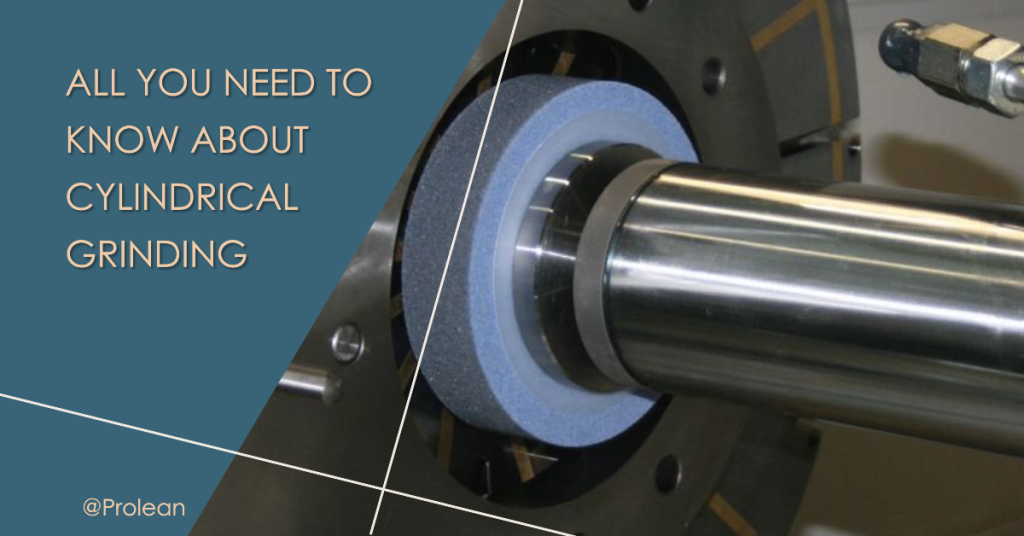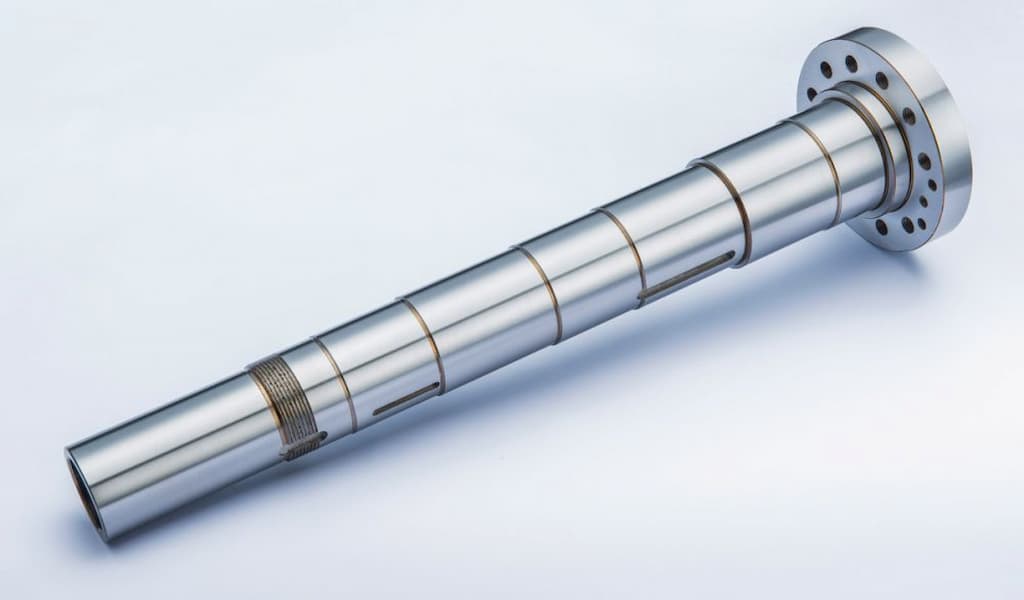“Cylindrical grinding cuts the minor materials from the surface of the cylindrical item to the specified dimension and also provides the smooth finish”

As the name suggests, cylindrical grinding precisely cuts the materials from the surface of cylindrical parts using abrasive. It is suitable for surface finishing of axially symmetric parts like rods, tubes, bushings, and rollers.
This accurate grinding method can work on both internal and external cylindrical surfaces. Its precision and diversity serve diverse industries, from automotive & aerospace to medical Furthermore, the cylindrical grinding process and its uses will be detailly discussed in this article.
The Basics of Cylindrical Grinding
To grasp the basics, let’s start with what is cylindrical grinding? It is a grinding machining process that refines the surface of cylindrical parts by removing a small amount of material. It utilizes a rotating grind wheel to achieve precise diameter, surface finish, and tolerances.
Moreover, the grinding machining service process also impacts the properties of the grinding surface, like hardness, strength, and thermal conductivity. The reason is that the process changes the top layer’s microstructure of workpiece material.

Cylindrical grinding
The working of cylindrical grinding process is similar to a lathe machine, using a grinding wheel as a cutting tool. Both the spindle and workpiece rotate relative to each other. Meanwhile, the abrasive wheel cuts the material as it touches the surface.
The modern cylindrical grinding machine integrated with CNC technology can automate all these movements and parameters ( depth, speed, feed, etc) with numerical control. The cnc grinder also improves precision and high-volume production efficiency.
Common Abrasives for Grinding Wheels
The workpiece material and desired finish level determine which abrasive to use for the wheel in the cylindrical grind. Additionally, the finish quality might differ on the distribution of abrasive and grain size even for the same abrasive material. So, you can follow the Custom Grinding by customizing the abrasive layer on the wheel surface based on the required grain size and density.
- Aluminum Oxide
- Cubic Boron Nitride (CBN)
- Silicon Carbide
- Ceramic Alumina
- Zirconia Alumina
- Diamond
Try Prolean Now!
The Steps of the Cylindrical Grinding Process
Let’s further break down the cylindrical grinding finish with the detailed steps of the grinding process from workpiece setup to final inspection.
1. Workpiece Setup
The process starts with mounting the workpiece between centers or clamping in a chuck. The stable workpiece setup is essential for accuracy as slight deflection can cause significant irregularities and defects.
2. Grinding Wheel Setup
After securely setting the workpiece, choose the best abrasive type for the project and customize it to meet all the requirements. The customization involves cutting the surface of the wheel to expose sharp abrasive grains for cutting.
3. Position and Alignment
Next, aligning the grinding wheel involves adjusting the position of the wheel relative to the correct angle and height of the workpiece. Also, the operator needs to fix the RPM, cutting depth, and other parameters.
4. Grinding
First, rough grinding is done with the coarser wheel surface to remove excess material from the workpiece rapidly. After this pre-stage achieves the approximate dimensions, a finer grit wheel provides the final surface finish and tolerances. During fine grinding, the parameters are adjusted to access more control over the operation.
5. Measurement and Inspection
Final inspection and measurement involves verifying the dimensions, surface finish level (Ra value), and required tolerances. In these steps, the manufacturer uses several tools and equipment like micrometers, CMM machines, and roughness testers.
What are the Advantages of Cylindrical Grinding?
Tight Tolerances
The cylindrical grinder can achieve tight tolerances. They can remove the material with great control from the surface of the machined parts to exact specifications. The small grains-size with uniform distribution on the rotating wheel results in fine radial tolerances ( ±0.0005” ).
High Quality Finish
The cylindrical grinding finishes the surface of simple & complex cylindrical items accurately, with Roughness(Ra) value as low as 0.025 µm. Additionally, with a proper wheel and optimized grinding variables, it can also create a mirror-like finish on the cylinder surface.
Automation
The cylindrical grinder can be easily automated with the integration of CNC technology. The CNC grinding machines can automatically dictate the movement of the workpiece and feeding according to digital instructions.
Versatile Material Range
Next, we can grind numerous materials with a cylindrical grinding strategy. Name to few: steel, titanium, nickel, carbon steel, plastics, and composites.
Large-scale Production
The CNC grinders can work without interruption and quality deviation across the batches. Automation allows them to produce the same results within all grinding cycles. Next, the same tooling can be used for many cycles. All these benefits make this grinding suitable for mass production.
The Cons of Cylindrical Grinding
This grinding method has some limitations too. Here are some cons;
- This method focuses on the grinding of cylinder shapes and has limited capability to other geometries.
- A CNC Ginder costs more than a manual cylindrical grinding machine, so high upfront cost for setup.
- There is a risk of thermal damage due to friction, but it can be minimized by applying the coolants.
What are the Cylindrical Grinding Applications?
Different industries use cylindrical grinding for finishing round and symmetric components. It can perform both external and internal grinds. The precision and repeatability advantage makes it a preferred technique to grind the cylindrical surfaces of simple and complex parts. So, the applications are widespread, from aerospace parts to precise medical components and products.
For instance, radial grinding of the axial pump-piston enhances the smoothness and lowers the office of friction. Another example is the grinding of bearings to enhance the finish so it will be performed better under lubrication.

Cylindrical grind parts
Next, let’s see what kind of surface grinding applications it has on various industrial cylindrical components.
Table: Cylindrical Grinding Applications
| Application Area | Examples |
| Automotive | Shafts( crank, cam, transmission, steering, gear, etc), flywheels, brake cylinders, and more. |
| Aerospace | Eengine shafts, actuators, compressor shafts, hydraulic units, airfoil segments, etc. |
| Tool Manufacturing | Cutting tools, dies, molds, end mills, drill bits, and tool holders. |
| Electronics and Semiconductor | Connector molds, pins, motor shafts, sozzles, sensor components, etc. |
| Hydraulics | Hydraulic cylinders, pistons, rods, valve spools, end caps, etc. |
| Medical Devices | Implants, orthopedic joints, stents, catheters, scalpel handles, surgical components, etc. |
| Marine | Various shafts, couplings, valve stems, rudder stocks, and bearings. |
Cylindrical Grinding Vs Centerless Grinding
Although both methods are suited for round and cylinder shapes, centerless grinding does not involve any fixed center to attach the workpiece as it is mounted with the center of the chuck in the cylindrical grinding. Instead, the workpiece is positioned between an abrasive wheel and an extra regulating wheel mechanism with the work support blase.
The tables below show the differences in Cylindrical vs Centreless Grinding based on various features/criteria;
Table: Cylindrical vs Centerless Grinding
| Features | Cylindrical Grinding | Centerless Grinding |
| Workpiece Mounting | Requires mounting between centers or a chuck. | No fixed center, instead blade support provides stability. |
| Precision | High precision for concentricity and roundness. | Efficient but less precise than cylindrical |
| Speed of Operation | Slower due to higher setup time | Speed production & suitable for high-volume production. |
| Workpiece complexity | It can handle complex shapes and sizes. | Best suited for simple and small-sized parts. |
| Setup Complexity | More complex setup and adjustment. | Simpler setup with flexible adjustment |
Some Cylindrical Surface Grinding Tips
- Remove all debris from the center holes of the workpiece and spindles. It prevents the uneven rotation.
- Fit tapers of the work centers securely into the workpiece (headstock and tail stock) to avoid any possible movement during grinding. Also, they must be perfectly aligned.
- Maintain a consistent and sufficient center depth in the part to preserve grinding accuracy.
- Apply lubrication in the dead centers to prevent the risk of damage during workpiece ejection.
- Regularly monitor and verify the alignment of two centers.
Grinding & Finishing Services at ProleanTech
At Proleantech, we have CNC-integrated universal and cylindrical grinders to handle the diverse shapes and materials. We can tightly achieve the desired tolerances and smoothness ( low Ra value). Consequently, our custom grinding strategy optimizes the results. We exactly match the requirements and material type with the correct abrasive and grain size to customize the grinding wheel.
You can trust us for any grinding solutions, regardless of which material or application. Our engineers will work closely with you to meet your quality and durability expectations!
Furthermore, We also have other surface finishing facilities like anodizing, plating, bead blasting, and polishing. So, send us your design to start the collaboration!
Try Prolean Now!
Summing Up
The right grinding technique can make the parts shiny and precise with minor material cutting from the surface. Since every grinding method has some specific implication, cylindrical grinding is ideal for finishing cylindrical geometries. You can achieve any finish and dimensional specifications on cylinder parts with the use of the right abrasive layer on the wheel, correct grinding parameters, and expert handling.
FAQs
What is a cylindrical grinding machine?
It is a type of grinder that shapes and finishes the cylinder shapes by rotating them against a grinding wheel.
How does cylindrical grinding differ from other grinding methods? Cylindrical grinding specifically shapes round objects, providing exceptional precision and surface quality. Meanwhile, other grinding methods can handle various shapes.
Is cylindrical grinding accurate?
Yes, cylindrical grinding is highly accurate. It achieves tolerances within microns and produces very fine surface finishes.
Can I use cylindrical grinding on any parts and materials?
Cylindrical grinding is versatile but best suited for cylindrical metallic items. It requires specific setups based on material type to avoid possible damage.




0 Comments